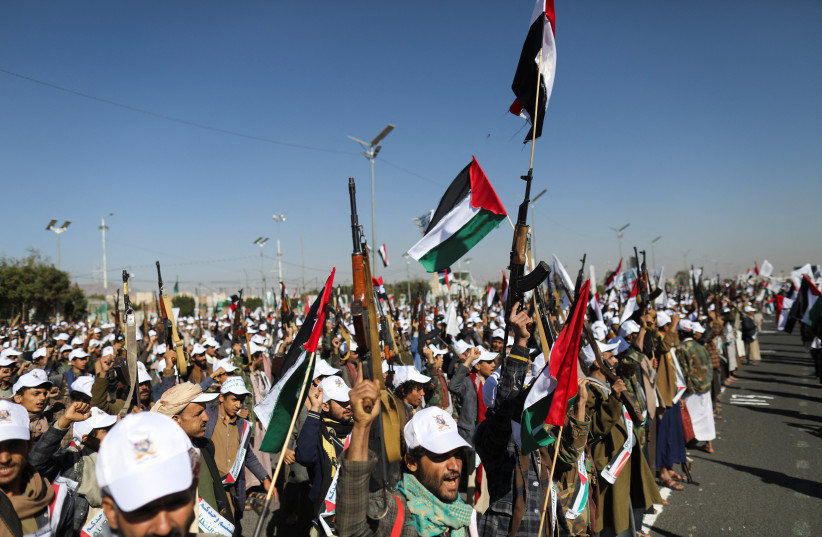The US and UK, along with other allies have acted to deter the continued Iran-backed Houthi attacks on shipping in the Red Sea. The Houthi group in Yemen have systematically increased their attacks and escalated their threats against international shipping. They initially began in October to try to target Israel with drones and missiles. Then they shifted to trying to blockade Israel by claiming to target commercial ships linked to Israel. Then they expanded their attacks to include many ships and threatened US, UK and French naval ships.
The White House said on January 11 that together with the UK, and with support from Australia, Bahrain, Canada and the Netherlands, the US targeted the Houthis in Yemen. The US says these attacks struck a number of targets. The attacks are a response to almost thirty attacks by the Houthis targeting ships in the Red Sea. Many of these attacks have involved numerous drones and missiles and have threatened dozens of ships.
The US Navy, along with the British and French navy, have helped to intercept attacks. The US also launched Prosperity Guardian, a task force of various navies, to help stop these attacks last month. So far the Houthis have continued to act with impunity. They have even used small boats to harass ships and the US sank several small boats recently.
There will be many questions in coming days about whether these strikes were successful and whether the Houthis will be deterred. It is in Iran’s interest to continue to escalate tensions in the region. Iran backs the Houthis and has been closely involved in trying to bring the Houthis into the regional conflict which Hamas began on October 7.
The Houthis are one element the Iranians use alongside Hezbollah, Hamas, Palestinian Islamic Jihad, militias in Syria, as well as Iran-backed militias in Iraq, in a multi-front conflict targeting Israel and the US. Iran has sought to exploit the Hamas attack on October 7 to create a regional conflict. Iran’s goal in this war is to reduce US influence in the region, sabotage further normalization agreements between Israel and other countries in the region, and also to bring Hamas to prominence in the West Bank so it can supplant the Palestinian Authority.

It took two months to take the Houthi threat seriously
Iran has used the Houthis to attack shipping in an unprecedented campaign against shipping in the Red Sea. The Red Sea is a strategic shipping lane and some shipping companies have called off shipping via this route and Suez to Europe, forcing ships to take the longer and more arduous route around the Cape of Good Hope in South Africa.
It took two months to take the Houthi threats seriously. While the threats began in October, it was not initially clear whether they would escalate or continue to lob a few drones and missiles toward Eilat, to show that they could. The Houthis initially wanted to show support for Hamas but they weren’t sure how much they wanted to get involved. The Iranians have helped arm the Houthis since at least 2015 when the group tried to take over Yemen. At the time the Saudis intervened in Yemen to try to stop them taking Aden.
Riyadh was initially successful backing the Yemen government against the Houthis. However, Saudi Arabia and its partners got bogged down in Yemen. Eventually a ceasefire was put into place recently in Yemen and China helped broker normalization between Saudi Arabia and Iran. This means Saudi Arabia was reticent to see new escalation in the Red Sea. But the Houthis moved forward anyway, prodded by Iran. Iran had already sent Shahed 136 drones to Yemen in late 2020, the same drones Iran exported to Russia for Moscow’s war in Ukraine. This matters because Iran sees the Houthis as a proxy and test bed. They use the Houthis to attack ships as one of the many Iranian tentacles in the region.
Now the US, UK and others have helped to strike back and hopefully deter more aggression. The countries involved are important. Bahrain is the sole regional country but it likely has support from some neighbors. The US and UK have often participated in regional conflicts together, such as on Iraq policy in the 1990s and 2000s. Canada and Australia likely supported the strikes in part because they are part of the Five Eyes network of countries, which includes the US, UK and New Zealand. All these countries are major economies that care about the freedom of the seas and international shipping. Now a line has been drawn in the Red Sea. The question is whether the Houthis will continue to cross it.
